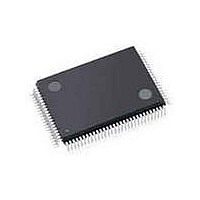C8051F040-TB Silicon Laboratories Inc, C8051F040-TB Datasheet - Page 297

C8051F040-TB
Manufacturer Part Number
C8051F040-TB
Description
BOARD PROTOTYPING W/C8051F040
Manufacturer
Silicon Laboratories Inc
Type
MCUr
Specifications of C8051F040-TB
Contents
Board
Processor To Be Evaluated
C8051F04x
Interface Type
USB
Lead Free Status / RoHS Status
Contains lead / RoHS non-compliant
For Use With/related Products
C8051F040
Lead Free Status / Rohs Status
Lead free / RoHS Compliant
- Current page: 297 of 328
- Download datasheet (3Mb)
C8051F040/1/2/3/4/5/6/7
23.2. Timer 2, Timer 3, and Timer 4
Timers n are 16-bit counter/timers, each formed by two 8-bit SFRs: TMRnL (low byte) and TMRnH (high
byte) where n = 2, 3, and 4 for timers 2, 3, and 4 respectively. These timers feature auto-reload, capture,
and toggle output modes with the ability to count up or down. Capture Mode and Auto-reload mode are
selected using bits in the Timer n Control registers (TMRnCN). Toggle output mode is selected using the
Timer 2, 3, and 4 Configuration registers (TMRnCF). These timers may also be used to generate a square-
wave at an external pin. As with Timers 0 and 1, Timers n can use either the system clock (divided by one,
two, or twelve), external clock (divided by eight) or transitions on an external input pin as its clock source.
The Counter/Timer Select bit C/Tn (TMRnCN.1) configures the peripheral as a counter or timer. Clearing
C/Tn configures the Timer to be in a timer mode (i.e., the system clock or external clock as input for the
timer). When C/Tn is set to 1, the timer is configured as a counter (i.e., high-to-low transitions at the Tn
input pin increment (or decrement) the counter/timer register). Refer to
Section “17.1. Ports 0 through 3
and the Priority Crossbar Decoder” on page 204
for information on selecting and configuring external I/
O pins for digital peripherals, such as the Tn pin. Timer 2 and 3 can be used to start an ADC Data Conver-
sion and Timers 2, 3, and 4 can schedule DAC outputs. Only Timer 1 can be used to generate baud rates
for UART 1, and Timers 1, 2, 3, or 4 may be used to generate baud rates for UART 0.
Timer n can use either SYSCLK, SYSCLK divided by 2, SYSCLK divided by 12, an external clock divided
by 8, or high-to-low transitions on the Tn input pin as its clock source when operating in Counter/Timer with
Capture mode. Clearing the C/Tn bit (TMRnCN.1) selects the system clock/external clock as the input for
the timer. The Timer Clock Select bits TnM0 and TnM1 in TMRnCF can be used to select the system clock
undivided, system clock divided by two, system clock divided by 12, or an external clock provided at the
XTAL1/XTAL2 pins divided by 8 (see SFR Definition 23.9). When C/Tn is set to logic 1, a high-to-low tran-
sition at the Tn input pin increments the counter/timer register (i.e., configured as a counter).
23.2.1. Configuring Timer 2, 3, and 4 to Count Down
Timers 2, 3, and 4 have the ability to count down. When the timer’s respective Decrement Enable Bit
(DCEN) in the Timer Configuration Register (See SFR Definition 23.9) is set to ‘1’, the timer can then count
up or down. When DCEN = 1, the direction of the timer’s count is controlled by the TnEX pin’s logic level.
When TnEX = 1, the counter/timer will count up; when TnEX = 0, the counter/timer will count down. To use
this feature, TnEX must be enabled in the digital crossbar and configured as a digital input.
Note: When DCEN = 1, other functions of the TnEX input (i.e., capture and auto-reload) are not available.
TnEX will only control the direction of the timer when DCEN = 1.
Rev. 1.5
295
Related parts for C8051F040-TB
Image
Part Number
Description
Manufacturer
Datasheet
Request
R
Part Number:
Description:
SMD/C°/SINGLE-ENDED OUTPUT SILICON OSCILLATOR
Manufacturer:
Silicon Laboratories Inc
Part Number:
Description:
Manufacturer:
Silicon Laboratories Inc
Datasheet:
Part Number:
Description:
N/A N/A/SI4010 AES KEYFOB DEMO WITH LCD RX
Manufacturer:
Silicon Laboratories Inc
Datasheet:
Part Number:
Description:
N/A N/A/SI4010 SIMPLIFIED KEY FOB DEMO WITH LED RX
Manufacturer:
Silicon Laboratories Inc
Datasheet:
Part Number:
Description:
N/A/-40 TO 85 OC/EZLINK MODULE; F930/4432 HIGH BAND (REV E/B1)
Manufacturer:
Silicon Laboratories Inc
Part Number:
Description:
EZLink Module; F930/4432 Low Band (rev e/B1)
Manufacturer:
Silicon Laboratories Inc
Part Number:
Description:
I°/4460 10 DBM RADIO TEST CARD 434 MHZ
Manufacturer:
Silicon Laboratories Inc
Part Number:
Description:
I°/4461 14 DBM RADIO TEST CARD 868 MHZ
Manufacturer:
Silicon Laboratories Inc
Part Number:
Description:
I°/4463 20 DBM RFSWITCH RADIO TEST CARD 460 MHZ
Manufacturer:
Silicon Laboratories Inc
Part Number:
Description:
I°/4463 20 DBM RADIO TEST CARD 868 MHZ
Manufacturer:
Silicon Laboratories Inc
Part Number:
Description:
I°/4463 27 DBM RADIO TEST CARD 868 MHZ
Manufacturer:
Silicon Laboratories Inc
Part Number:
Description:
I°/4463 SKYWORKS 30 DBM RADIO TEST CARD 915 MHZ
Manufacturer:
Silicon Laboratories Inc
Part Number:
Description:
N/A N/A/-40 TO 85 OC/4463 RFMD 30 DBM RADIO TEST CARD 915 MHZ
Manufacturer:
Silicon Laboratories Inc
Part Number:
Description:
I°/4463 20 DBM RADIO TEST CARD 169 MHZ
Manufacturer:
Silicon Laboratories Inc










